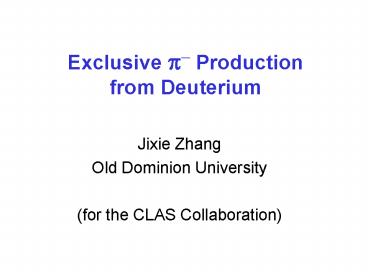Exclusive p Production from Deuterium - PowerPoint PPT Presentation
Title:
Exclusive p Production from Deuterium
Description:
Barely off-shell Nucleon Structure (BoNuS) Electron beam ... 18. Baryonic resonances, D(e, e p- pCLAS)p. E = 5.3 GeV, Accepance and momentum not corrected yet ... – PowerPoint PPT presentation
Number of Views:75
Avg rating:3.0/5.0
Title: Exclusive p Production from Deuterium
1
Exclusive p? Production from Deuterium
- Jixie Zhang
- Old Dominion University
- (for the CLAS Collaboration)
2
Motivation
- Proton resonances have been studied in detail
with high statistics. - Neutron resonances are also very interesting. It
has different isospin (Iz) than the proton. - However, we have almost no data yet because
there are no free neutron targets. - Most of the data we have were taken with
deuteron targets, so we do not know the initial
state of the neutron (binding and Fermi motion
effects) .
K.Park et al, CLAS collaboration, submitted to
physics review C
3
Solution
Scatter the electron from a neutron in the
deuteron and detect the spectator proton.
Low momentum spectator proton
Conservation of energy and momentum allows
determine the initial state of the neutron.
4
Jefferson Lab Experiment E03-012Barely off-shell
Nucleon Structure (BoNuS)
- Electron beam energies 2.1, 4.2, 5.3 GeV
- Spectator protons were detected by the newly
built Radial Time Projection Chamber (RTPC) - Scattered electrons and other final state
particles were detected by CEBAF Large Acceptance
Spectrometer (CLAS) - Target 7 atm D2 gas
- Data were taken from Sep. to Dec. in 2005
5
BoNuS RTPC Detector
- Low momentum protons from the target ionize
He/DME gas in the drift region (30 to 60 mm from
the target) - Ionization electrons drift to the three layers of
Gaseous Electron Multipliers (GEMs) - Sensitive to proton momenta between 66 and 200
MeV/c - GEMs are read out by 3200 channels (pads) in 114
ns time windows - 3-Dimensional Tracking
- time of flight -gt R
- 2D channel position -gt q, z
6
CEBAF Large Acceptance Spectrometer
EC
TOF
CC
DC 3
DC 2
e-
DC 1
Beam Line
BoNuS RTPC
Target 7 atm. D2 gas
low energy backwards proton
CLAS
7
p- Production Kinematics
g n -gt p- p
p-
q
Q2 momentum transfer to the target W
invariant mass of virtual photon target neutron
(not at rest)
n
Leptonic plane
hadronic plane
q angle of emitted p- with respect to
direction of virtual photon in the CM frame f
angle between the leptonic and hadronic
scattering planes
8
Missing Mass, E 5.3GeV, No momentum calibration
N(e,e?p-)X
D(e,e?p-pCLAS)X
PRELIMINARY
D(e,e?p-pRTPC)X
D(e,e?p-pRTPCpCLAS)X
9
Spectator momentum spectrum
D(e, e? p- p)p
D(e, e? p- pCLAS)ps
D(e, e? p- pRTPC)pCLAS
10
Kinematics coverage, D(e,e?p-p)p , E 5.3 GeV
q Vs f
f(degree)
W Vs Q2
11
Baryonic resonances, D(e,e?p-p)p E 5.2 GeV,
Accepance and momentum not corrected yet
N(1520)D13, N(1535)S11
D(1620)S31, N(1650)S11 N(1675)D15, N(1680)D15
D(1700)D33, N(1720)P13
D(1232)P33
PRELIMINARY
12
Summary
- The Bonus RTPC detector, together with the CLAS
detector, allows us to study the neutron
resonances clearly. - We have taken data for D(e,e?p-p)p over a large
kinematic range in q and f, Q2 and W - We presented preliminary results for the p-p
invariant mass showing N resonances - Momentum and acceptance corrections still need to
be applied. - Results from other beam energies are coming soon
2.1, 4.2 GeV
13
Final States Interaction
quasi-free D(e,e?p-ps)p process
primary background
This final state interaction is small for low
momentum ps and has a very strong angular
dependence on qpq, which is the angle between q
and p- in cm frame.
14
Angular Acceptance (q and f)
PRELIMINARY
15
Missing Mass, E5.3 GeV
N(e,e?p-)X
D(e,e?p-p)X
PRELIMINARY
D(e,e?p-prtpc)p
D(e,e?p-prtpcpCLAS)X
?0
p0
r0/ w0
16
W in Q2 bin, E5.3 GeV, No acceptance calibration
PRELIMINARY
PRELIMINARY
17
BoNuS RTPC Detector
18
Baryonic resonances, D(e, e? p- pCLAS)pE 5.3
GeV, Accepance and momentum not corrected yet
Invariant mass of p- and pCLAS
D13(1520), S11(1535)
S31(1620), S11(1650), D15(1675), F15(1680),
D33(1700), P11(1710)
P33 (1232)
PRELIMINARY
19
Data on the proton - nothing comparable exists
for the neutron
p(e,e?np)
CLAS
20
Resonance Transition Amplitudes(compared to a
quark-model description)
- Proton
- Neutron































